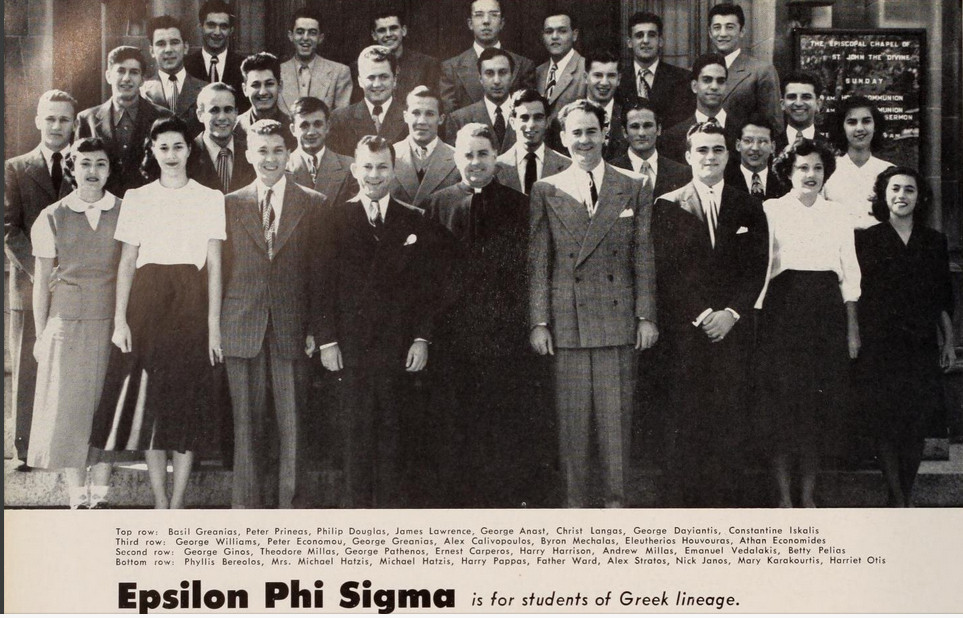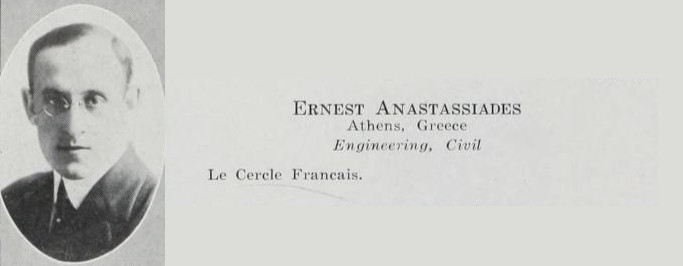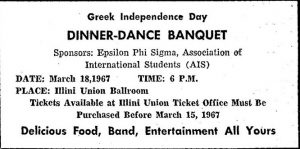Since at least 1873, Greek students have been attending the University of Illinois at Urbana-Champaign. Early Greek Illini have included aeronautical engineers, agriculturalists, architectural engineers, business administrators, chemists, civil engineers, electrical engineers, elementary education teachers, entrepreneurs, french instructors, mathematics instructors, and transfer students. Read on the learn more about early Greek Illini!
- A 1949 Illio group photo of Epsilon Phi Sigma, found in Record Series 41/8/805.
Greek Cultures On Campus
Before the first Greek Illini arrived, some early University students were already speaking (or at least reading) Greek. In the early years of the University, students were required to study Elementary Latin and Greek. Not all students were happy about the foreign language requirement. However, some faculty were delighted to offer the study of Greek Language. Over time, this requirement was omitted but the program continued to include advanced language study. Many distinguished Greek Language scholars taught the language. From 1891 until 1918, Dr. Melville Moss taught Greek and he was a well regarded instructor known for his exceptional interest in the well-being of his students. In retirement, Dr. Moss devoted his time to translating Greek works held in the University Library which are still available today, including The Clouds of Aristophanes (with Professor William Abbot Oldfather) and The Orations of Dinarchus and the Fragments of (Demades). In fact, The Clouds of Aristophanes was performed on campus in 1910. Another Illinois scholar of Greece was Professor William Abbot Oldfather. From 1904 until 1945, Dr. Oldfather was part of the classical studies faculty at the University. He was the General Editor for Illinois Studies in Languages and Literature too. In particular, Dr. Oldfather is known for his studies of the Locris of Greece. Dr. Oldfather was also an avid hiker of Illinois and his personal papers include his recollections of hiking in East Central Illinois titled “An Appreciation of the Region From the Hiker’s Point of View”.
Early Agriculturalists
Mr. Panagiottis Gennadius (B.S. Agriculture, 1878), from Athens, Greece, was the first Greek graduate of the University of Illinois. [1] As a student, Mr. Gennadius was both a research assistant and a University French instructor (1873-1875). [2] After completing his degree with the thesis “Nitrous Acid in Plants”, Mr. Gennadius returned to Athens where he published prolific research into agricultural pests and other issues in agriculture. In time, he was known for his monumental botanical lexicon “A Dictionary of the Plants of Greece”. [3] Mr. Gennadius also taught natural history in Athenian high schools. Later, Mr. Gennadius left academia for work in government administration in Cyprus. Towards the end of his life, he bequeathed his personal library of 3,300 books to the National Library of Greece.
After moving to Chicago at age eleven, Mr. George Bouyoucos, (B.S. Agriculture, 1909) came to the University of Illinois to begin a long distinguished career in soil sciences. [4] While he lived in Chicago, Dr. Bouyoucos learned English at the Hull House (where the University of Illinois at Chicago campus and its Hull House Museum stands today). [5] After completing his bachelors degree here, Mr. Boyoucos continued his education and he earned a PhD at Cornell University just two years later. Dr. Bouyoucos became a professor at Michigan State University. During the course of his career, Dr. Bouyoucos earned two Greek awards: the Cross of our Savior and the Cross of Phoenix.
As a student, Mr. Bouyoucos was active in multiple student organizations and he was an entrepreneur too. According to the Daily Illini, Mr. Bouyoucos built and ran a confectionary store in-town while he was an undergraduate. As a student leader, Mr. Bouyoucos gave talks about politics and higher education in Greece through student clubs like Adelphic Society as well as agriculture in Greece and religion in Greece through Agriculture Club. Mr. Bouyoucos even ran for Sophomore class president, before becoming president of the Adelphic Society. Finally, during senior year, he helped organize the early student efforts to successfully produce varsity themed belts which were “noticeable but not gaudy” the Daily Illini reported.
- A 1909 Illio profile photo of George Bouyoucos, found in Record Series 41/8/805.
Mr. Ernest Anastassiades, (B.S. Civil Engineering, 1919) might be the first undergraduate Greek civil engineer. Like Mr. Gennadius before him, Mr. Anastassiades was active in French culture on campus too. He performed in a French Club performance of the Moliere comedy “Le Médecin malgré lui” (The Doctor in Spite of Himself) and he became vice president the following year. In 1919, the comedy continued in print as the Daily Illini cited Mr. Anastassiades and nine other students for having the longest last names on campus. After graduation, Mr. Anastassiades, took a government job the Daily Illini reported.
- A 1919 Illio profile photo of Ernest Anastassiades, found in Record Series 41/8/805.
Early Illinois Faculty Working in Greece
Agronomy Professor Cyril George Hopkins was a soil specialist and a well regarded instructor who later died during a strenuous experience working for the Red Cross in Greece where he served during his sabbatical. In October 1918, he left for Greece where he would conduct research on soil conditions to help Greek agriculturalists work better. While in Greece, he was joined by other scholars including his former student Dr. George Bouyoucos. In fact, the Daily Illini reported that during this trip there were plans made for the Greek government to send Greek students to the United States to study agriculture too. By September 1919, it was announced that Professor Hopkins was preparing to return to the United States. Shortly into the trip, he became seriously ill and he was taken to a British military hospital in Gibraltar. Six days later, he passed. Dr. Bouyoucos brought Dr. Hopkins body home. For Professor Hopkins’ last rights, the University suspended all exercises and arranged a funeral in the auditorium. A memorial service was organized at the following January conference, on campus, for out-of-town colleagues who planned to see him. At the memorial service, permanent memorial plans were discussed. The new campus agriculture building was to be named in tribute to him. Further, it was proposed that Professor Hopkins’ experimental farm in Marion County, Illinois be purchased and maintained by Hopkins Memorial Association. [6] Professor Hopkins received the Order of Our Savior medal from the King of Greece for his services.
Later Agriculturalists
Mr. James G. Kallas, (B.S. Agriculture, 1922) was both an active student leader and an athlete too. His junior year might have been his most active year. In early May of his sophomore year, he took an award under a livestock contest for his cattle entry. In late fall of his junior year, Mr. Kallas was elected secretary and treasurer of Agriculture Club. By spring, he joined the multicultural student organization Cosmopolitan Club. If Mr. Kallas was not busy enough, he was a welterweight wrestler, he performed at the 1921 Annual Ag Round-Up, and he earned a minor I in athletics too.
- A 1923 Illio profile photo of James G. Kallas, found in Record Series 41/8/805.
Mr. Constantine John Alexopoulos, (B.S. Agriculture, 1928-29; M.S. Horticulture 1928; PhD Botany 1932) became a distinguished mycologist. [7] Born in Chicago to Greek parents, Dr. Alexopoulos attended elementary school in Greece but high school in Chicago. He earned all three of his college degrees at the University of Illinois and he remained as an instructor for a few years too. Later, Dr. Alexopoulos became a tenured professor at the University of Texas at Austin.
Dr. Alexopoulos was a regular Daily Illini reader and he wrote at least two editorials in defense of both the Greek nation and the Greek immigrant population of Illinois. In 1924 he wrote a response criticizing a disparaging comment on the current state of the Greek economy. Again in 1927, after a guest lecturer on campus (a judge) accused immigrant Greeks as causing recent increased crime in Chicago, Dr. Alexopoulos again wrote a detailed editorial with citations too.
- A 1924 Daily Illini editorial by Mr. Alexopoulos, found in Record Series 41/8/802.
- A 1924 Daily Illini editorial by Mr. Alexopoulos, found in Record Series 41/8/802.
- A 1927 Daily Illini editorial by Mr. Alexopoulos, found in Record Series 41/8/802.
- A 1927 Daily Illini editorial by Mr. Alexopoulos, found in Record Series 41/8/802.
- A 1927 Daily Illini editorial by Mr. Alexopoulos, found in Record Series 41/8/802.
Dr. Alexopoulos was also active in his faith at the Chapel of St. John the Divine, where he organized Greek cultural events off campus, including folk dances, songs, and serenades too. During his last years at the University, Dr. Alexopoulos with Dr. Mylonas spoke on Greek immigration and the Greek organization Ahepa which supported Greek immigrants in obtaining U.S. citizenship.
- A 1928 Illio profile photo of Constantine J. Alexopoulos, found in Record Series 41/8/805.
Mr. Constantine Demetrios Zannis, (B.S. Chemistry, 1930), may have been the first Greek Illini to complete an undergraduate degree in Chemistry.
- A 1930 Illio profile photo of Constantine D. Zannis, found in Record Series 41/8/805.
Mr. John George Kilavos, (B.S. Agriculture, 1932) joined the Poultry Institute in Athens, following graduation.
- A 1932 Illio profile photo of John George Kilavos, found in Record Series 41/8/805.
Early Engineers
The 1950s campus saw a great increase in Greek engineers on campus. In particular, many 1950s undergraduate Greek Illini were electrical engineers.
Mr. Isaac David Nehama, (B.S. Electrical Engineering, 1950) was born to a Sephardic Jewish couple, from the Monastir Vilayet of the Ottoman Empire, who came to Athens after World War One. [8] [9] As World War Two approached the Nehama home, Mr. Nehama was able to flee but his family did not. After the war, Mr. Nehama returned and he learned that only his father survived.
Mr. Nehama came to the University on a scholarship and he completed two degrees in electrical engineering. As a student, he was involved in multiple student organizations. In fact, in 1950, he was nominated as the Alpha Epsilon Phi candidate for the campus wide King of the Spring Carnival as a representative. Although he did not win, he was selected as a member of the king’s court.
- A 1950 Illio profile photo of Isaac David Nehama, found in Record Series 41/8/805.
- A 1955 Illio profile photo of Evangelos D. Argoudelis, found in Record Series 41/8/805.
- A 1956 Illio profile photo of Michael Megaloeconomos, found in Record Series 41/8/805.
Student Organizations
Form 1945 until 1971, students of Greek lineage organized the Epsilon Phi Sigma Gamma Chapter on the University of Illinois campus. Epsilon Phi Sigma was a national Greek letter organization for students of Greek lineage. The Gamma chapter arranged for speakers, dinners, fundraisers, picnics, parties, and Greek culture events through the YMCA’s Supper Club cultural dinner program. In 1965, on the Greek Independence Day, Epsilon Phi Sigma hosted a banquet with Cypriot Ambassador to the United States (and later Cypriot Ambassador to the United Nations) Zenon Rossides. For the next few years, the Independence Day banquets featured significant people representing or studying Greek cultures, including Greek Embassy Cultural Attache John Nicopoulos (1966), Director of the Institute for Balkan Studies at Thessaloniki Basil Laourdas (1967), and University of Missouri Professor of Classical Languages Meyer Reinhold (1968).
- A 1967 Daily Illini advertisement for a Greek Independence Day banquet, found in Record Series 41/8/802.
Since almost the first days of the University, Greek students have been a part of the University of Illinois. Today, the University campus features many buildings and organizations which are connected to the legacy of ancient Greek cultures. Of course, the University campus today includes many student organizations which proudly feature Greek letter names which are acronyms for their organizations’ mottos. From Mr. Gennadius’ world-traveling, pan-Hellenic career in agriculture, to Dr. Bouyoucos’ service to students on campus, Greece during the war, and the University during Dr. Hopkins’ passing, to Dr. Alexopoulos’s defense of Greek immigrants, to Mr. Nehama’s preservation of the memory the Jewish peoples of Greece and the Mediterranean Sea, to today, Greek Illini have continuously worked for a better world for Greeks and Illini everywhere.
Are you a Greek Illini? Do you know someone who is? We’d like to hear from you! Please send us a message or leave a comment below. We want to include you and your story, as we celebrate the first 150 years of the University of Illinois.
Happy First 150 everyone!
References
[1] “Panagiottis Gennadius ’74 Now Greek Minister at Crete”, Daily Illini, March 23, 1915, page 4. Mr. Gennadius was born into an exceptional family in Athens. For example, he was also the younger brother of Greek diplomat Johannes “John” Gennadius [Ιωάννης Γεννάδιος]. For J. Gennadius’ personal papers, please see: the Archives of the Gennadius Library.
[2] Report of the Board of Trustees
[3] The Daily Illini reported that a copy was donated to the University of Illinois Library. The complete title in Modern Greek is “Λεξικόν φυτολογικόν, περιλαμβάνον τα ονόματα, την ιθαγένειαν και τον βίον υπερδεκακισχιλίων φυτών”. See: “Panagiottis Gennadius ’74 Now Greek Minister at Crete”, Daily Illini, March 23, 1915, page 4.
[4] Dr. Bouyoucos’ faculty papers are available at the Michigan State University Archives. Please see: “George Bouyoucos Collection, UA.17.6“.
[5] At the University of Illinois at Chicago, guests are welcomed to visit the Hull House Museum and to see the Hull House archives at the Department of Special Collections and University Archives.
[6] For detailed information about the plan, please see: Illinois Farmers’ Institute: A Hanbook of Agriculture. Proceedings of the Twenty-fifth Annual Meeting. February 18, 19, and 20.
[7] For a biography, please see: Brodie, Harold J. “Constantine John Alexopoulos, 1907-1986.” Mycologia, vol. 79, no. 2, 1987, pp. 163–165.
[8] Mr. Nehama gave a talk about his family’s immigration and holocaust experiences. Please see: “Holocaust Lecture Series: Isaac Nehama”, Vanderbuilt University.November 13, 2011. For more information about his life, please see: “Isaac David Nehama“, The Washington Post, November 13, 2014.
[9] Mr. Nehama contributed translations a collection of stories about the former Jewish people of Monastir. Please see: Kolonomos, Žamila. Bedford, Robert. Monastir Without Jews: Recollections Of A Jewish Partisan In Macedonia. New York : Foundation For The Advancement Of Sephardic Studies And Culture.

















